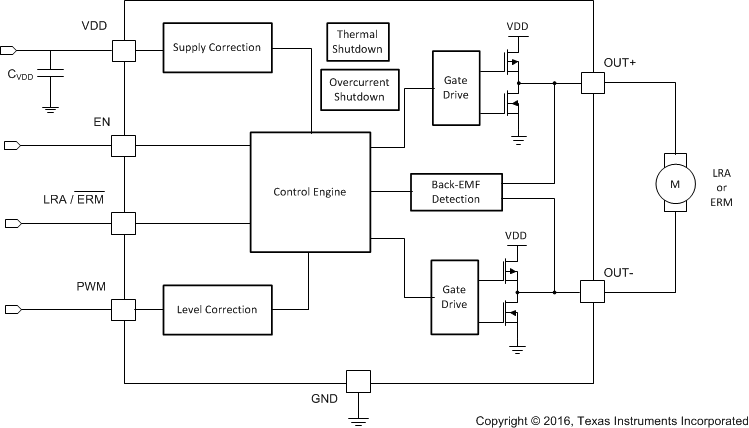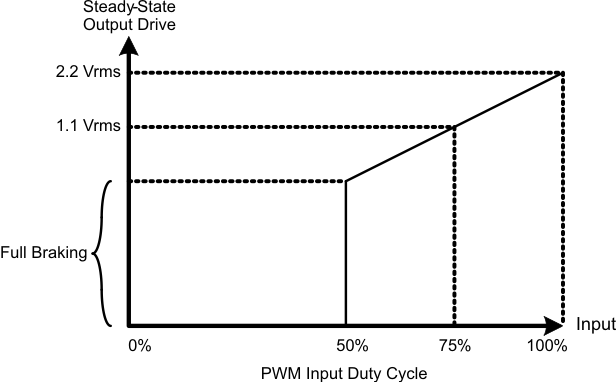SLOS754C June 2012 – August 2016 DRV2603
PRODUCTION DATA.
- 1 Features
- 2 Applications
- 3 Description
- 4 Revision History
- 5 Pin Configuration and Functions
- 6 Specifications
- 7 Parameter Measurement Information
-
8 Detailed Description
- 8.1 Overview
- 8.2 Functional Block Diagram
- 8.3
Feature Description
- 8.3.1 Supply Voltage Rejection for Constant Vibration Strength
- 8.3.2 Low-Voltage Control Logic for Constant Vibration Strength
- 8.3.3 Thermal Protection
- 8.3.4 Overcurrent Protection
- 8.3.5 Linear Resonance Actuators (LRA)
- 8.3.6 Auto Resonance Engine for LRA
- 8.3.7 Eccentric Rotating Mass Motors (ERM)
- 8.3.8 Edge Rate Control
- 8.4 Device Functional Modes
- 9 Application and Implementation
- 10Power Supply Recommendations
- 11Layout
- 12Device and Documentation Support
- 13Mechanical, Packaging, and Orderable Information
Package Options
Mechanical Data (Package|Pins)
- RUN|10
Thermal pad, mechanical data (Package|Pins)
- RUN|10
Orderable Information
8 Detailed Description
8.1 Overview
The DRV2603 is a haptic and vibratory driver designed specifically to meet the needs of haptic and vibration applications in the portable market. The DRV2603 has two modes of operation, ERM mode and LRA mode. ERM mode is designed to drive Eccentric Rotating Mass motors, which are generally DC motors of the bar or coin type. LRA mode is designed to drive Linear Resonance Actuators, also known as linear vibrators, which require an alternating signal that commutates at or very near the natural mechanical resonance frequency of the actuator. These actuators present a unique control challenge that is solved in the DRV2603 by auto resonance tracking.
8.2 Functional Block Diagram

8.3 Feature Description
8.3.1 Supply Voltage Rejection for Constant Vibration Strength
The DRV2603 features power supply feedback, so no external supply regulation is required. If the supply voltage drifts over time (due to battery discharge, for example), the vibration strength will remain the same so long as there is enough supply voltage to sustain the required output voltage. The DRV2603 can be connected directly to the battery.
8.3.2 Low-Voltage Control Logic for Constant Vibration Strength
The PWM input uses a digital level-shifter, so as long as the input voltage meets the VIH and VIL levels, the vibration strength will remain the same even if the digital levels were to vary. These benefits apply to both ERM mode and LRA mode.
8.3.3 Thermal Protection
The DRV2603 has thermal protection that will shut down the device to prevent internal overheating. See the Specifications for typical over temperature thresholds.
8.3.4 Overcurrent Protection
The DRV2603 has overcurrent protection that is useful in preventing damage from short conditions. The overcurrent protection monitors current from VDD, GND, OUT+, and OUT-. See the Specifications for typical overcurrent thresholds.
8.3.5 Linear Resonance Actuators (LRA)
Linear Resonant Actuators, or LRAs, only vibrate effectively at their resonant frequency. LRAs have a high-Q frequency response due to which there is a rapid drop in vibration performance at offsets of 2 to 3 Hz from the resonant frequency. Many factors also cause a shift or drift in the resonant frequency of the actuator such as temperature, aging, the mass the product to which the LRA is mounted, and in the case of a portable product, the manner in which it is held. Furthermore, as the actuator is driven to its maximum allowed voltage, many LRAs will shift several Hz in frequency due to mechanical compression. All of these factors make a real-time tracking auto-resonant algorithm critical when driving LRA to achieve consistent, optimized performance.
 Figure 9. Typical LRA Response
Figure 9. Typical LRA Response
8.3.6 Auto Resonance Engine for LRA
No frequency calibration or actuator training is required to use the DRV2603. The DRV2603 auto resonance engine tracks the resonant frequency of an LRA in real time. If the resonant frequency shifts in the middle of a waveform for any reason, the engine will track it cycle to cycle. The auto resonance engine accomplishes this by constantly monitoring the back-EMF of the actuator. The DRV2603 tracking range for LRA devices is 140 Hz to 220 Hz.
8.3.7 Eccentric Rotating Mass Motors (ERM)
Eccentric Rotating Mass motors, or ERMs, are typically DC-controlled motors of the bar or coin type. ERMs can be driven in the clockwise direction or counter-clockwise depending on the polarity of voltage across its two terminals. Bi-directional drive is made possible in a single-supply system by differential outputs that are capable of sourcing and sinking current. This feature helps eliminate long vibration tails which are undesirable in haptic feedback systems..
 Figure 10. Reversal of Motor Direction
Figure 10. Reversal of Motor Direction
Another common approach to driving DC motors is the concept of overdrive voltage. To overcome the inertia of the motor's mass, they are often overdriven for a short amount of time before returning to the motor's rated voltage to sustain the motor's rotation. Negative overdrive is also used to stop (or brake) an ERM quickly by reversing the magnetic field of the driving coil(s).
8.3.8 Edge Rate Control
The DRV2603 output driver implements Edge Rate Control (ERC). This ensures that the rise and fall characteristics of the output drivers do not emit levels of radiation that could interfere with other circuitry common in mobile and portable platforms. Because of ERC, no output filter or ferrites are necessary.
8.4 Device Functional Modes
8.4.1 LRA Mode
When in LRA mode, the DRV2603 employs a simple control scheme that is designed to be compatible with ERM mode signaling. A 100% input duty cycle gives full vibration strength, and a 0% to 50% input duty cycle gives no vibration strength. The auto resonance detection algorithm takes care of the physical layer signaling and commutation required by linear resonance actuators. The DRV2603 implements closed-loop operation comprising a simple feedback loop. If the back-EMF feedback tells the device that the vibration is too low relative to the input duty cycle, the DRV2603 will increase the vibration strength. If the back-EMF feedback tells the device that the vibration is too high relative to the input duty cycle, the DRV2603 automatically enforces a braking algorithm. It follows that a 0% to 50% input duty cycle will always enforce braking until the LRA is no longer moving. This form of signaling is used to preserve the same input format for both ERM and LRA drive; therefore, no software changes are required when switching between ERMs and LRAs with the DRV2603.
 Figure 11. LRA Mode
Figure 11. LRA Mode
The exact full-scale output voltage depends on the physical construction of the LRA itself. Some LRA devices give a small amount of back-EMF during full scale vibration, and other LRA devices give a much larger amount. A nominal full-scale output value is 2.2 VRMS, but it can typically vary as much as +/- 10% depending on the actuator's physical design. The output voltage can be approximated by the following equation between 50% and 100% input duty cycle.

Since the DRV2603 includes constant output drive over supply voltage, the output PWM duty cycle will be adjusted so that the relationship in the above equation will hold true regardless of the supply voltage.
8.4.2 ERM Mode
The DRV2603 is a compact, cost-effective driver solution for ERM motors. Most competing solutions require external components for biasing or level-shifting, but the DRV2603 requires only one decoupling capacitor giving a total approximate circuit size of 2 mm by 2 mm. This small solution size still comes packed with features such as a level-shifted input, differential outputs for braking, constant drive strength over supply, edge rate control, and a wide input PWM frequency range.
When in ERM mode, the DRV2603 employs a simple control scheme. A 100% input duty cycle gives full-strength forward rotation, a 50% input duty cycle give no rotation strength, and a 0% duty cycle give full-strength reverse rotation. Forcing the motor velocity towards reverse rotation is used to implement motor braking in ERMs. By stringing together various duty cycles over varying amounts of time, a haptic motor control signal will be constructed at the output to precisely drive the motor.
 Figure 12. ERM Mode
Figure 12. ERM Mode
The full-scale, open-load output voltage of the DRV2603 in ERM mode is 3.6V. The output stage has a total nominal RDS of 1.9 Ω. When driving a 20 Ω ERM at full-scale, the differential voltage seen at the outputs is approximately 3.3 V. When driving a 10 Ω ERM at full-scale, the output voltage is approximately 3.0 V.
The voltage seen at the outputs as a function of input duty cycle is given by this equation.

Since the DRV2603 includes constant output drive over supply voltage, the output PWM duty cycle will be adjusted so that the relationship in the above equation will hold true regardless of the supply voltage. The output duty cycle in ERM mode can be approximated by the following equation.
